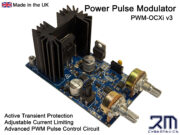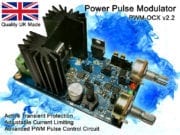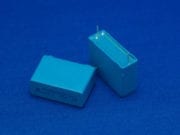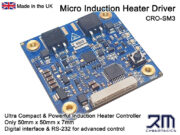A Simple DIY Solid State Tesla Coil
This Solid State Tesla Coil is easy to build, upgradeable and gives great results with only a a little work! This project shows how to make a small Tesla Coil that can run on batteries or any other suitable low voltage DC supply. From as little as 12V input it is possible to make high frequency plasma sparks that even play music! The result of this high voltage, high frequency output is being able to make awesome looking sparks and arcs of plasma in the air.
 WARNING: High Voltage Device! High Voltages can be very dangerous!
WARNING: High Voltage Device! High Voltages can be very dangerous!
What is an SSTC (Solid State Tesla Coil)?
What it is and how it differs from a classical Tesla Coil (SGTC) which uses a spark gap.
Like all Tesla Coils, a Solid State Tesla Coil (SSTC) is a type of high frequency resonant transformer which can step up a low voltage DC input into a very high frequency AC output. The main difference between a SSTC vs a SGTC is that the SSTC has no spark gap an instead uses modern transistor technology to switch the current in the primary coil. If you are not familiar with them, check our article on how a Tesla Coil works. There are many forms of SSTC which vary by how the transistors are configured or how the system is resonated. In this version, just a single IGBT is used to switch current in the primary at the resonant frequency of the secondary coil. By using a specialised PWM circuit (our Power Pulse Modulator PWM-OCXi v2) it is possible to tune into the right frequency and then adjust the power level with the turn of a knob.
There are a lot of articles online showing how to make an SSTC, but we like to think that this one must be one of the simplest and most cost effective ways of making one and without compromising on performance.
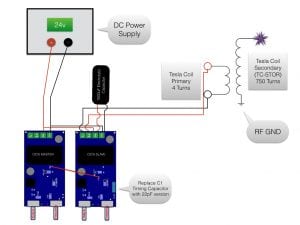 How to make an SSTC
How to make an SSTC
How to put the parts together to make a SSTC
If you choose to buy all the parts ready made then it is possible to get this Tesla Coil up and running in around five minutes! Only a few parts are required for this SSTC. These are detailed below along with how to put them together in a number of ways to make a simple mini solid state Tesla Coil.
For this project, you will need;
• Power Pulse Modulator PWM-OCXi v2 (Though it is feasible with only one OCXi, you will get a more stable and prolonged effect result with two!)
• A PSU with a voltage between 12V and 30V with a current of at least 5A. A large battery could also work, but take care not to let the voltage drop below 12V.
• A helical coil of around 750 turns (for the secondary coil)
• 10A (or larger) cable for winding primary coil
• A 1000uF, 50V (or more) electrolytic capacitor
• A 22pF timing capacitor (for the OCXi)
The Secondary Coil
The tall helical coil from which the sparks come
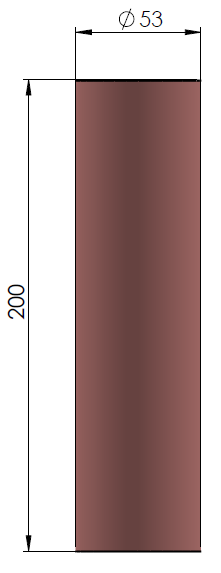 This part can be quite difficult and time consuming to produce yourself. If you do not want to wind your own, check out our helical coils or Tesla Coil Secondary coils which include a toroid. The exact size or number of windings are not critical as long as there is a relatively high number of turns on the secondary coil. Our coils use around 750 turns of 0.25mm magnet wire wound onto a PVC pipe of 53mm in diameter. This coil resonates at around 1MHz.
This part can be quite difficult and time consuming to produce yourself. If you do not want to wind your own, check out our helical coils or Tesla Coil Secondary coils which include a toroid. The exact size or number of windings are not critical as long as there is a relatively high number of turns on the secondary coil. Our coils use around 750 turns of 0.25mm magnet wire wound onto a PVC pipe of 53mm in diameter. This coil resonates at around 1MHz.
To make one yourself, find a suitable piece of pipe such as some drainage pipe or any other straight plastic tube that is around 20cm long. Start by fixing the start of your wire to one end of the coil then carefully turn the tube while holding the wire tight so that each turn lays right up against the previous turn. It is important to make all the turns tight and with no spaces or overlapping turns otherwise the coil may not operate efficiently. During winding it can be useful to add a small spot of super glue occasionally so that if you accidently let go, it wont all unwind and leave you with a tangled mess. When using magnet wire (enamel coated wire), it is necessary to scrape off the insulating layer at the ends so that a connection can be made. While this is not so important at the output side, it is essential at the base where there must be a good connection to RF ground.
The HV output will come from the top part of the coil. You should let a small bit of wire protrude away from the main body of the coil so that the electric field will be concentrated around it’s tip. The bottom of the coil must be connected to a suitable RF (radio frequency) Ground. This should not mains ground, or the GND connection of your power supply. This is because the high frequency can cause significant interference with other electronics. A suitable RF GND would be a connection to a metal filing cabinet, or a long metal stake in the earth.
The Primary Coil
Small coil pulsed with low voltage, high current
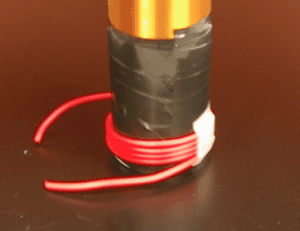 The primary coil simply consists of around four windings of thick copper wire wrapped around the base of the secondary coil. It is best to use something well insulated as it prevents corona leaking energy from the primary coil. In this example we used 10A silicone insulated wire as it is highly flexible, well insulated and easy to work with. Before coiling the primary winding onto the secondary coil, we wrapped a folded piece of A4 paper around the bottom and then coated the paper with insulating tape. This just helps to protect the fine secondary windings and also reduce corona leakage.
The primary coil simply consists of around four windings of thick copper wire wrapped around the base of the secondary coil. It is best to use something well insulated as it prevents corona leaking energy from the primary coil. In this example we used 10A silicone insulated wire as it is highly flexible, well insulated and easy to work with. Before coiling the primary winding onto the secondary coil, we wrapped a folded piece of A4 paper around the bottom and then coated the paper with insulating tape. This just helps to protect the fine secondary windings and also reduce corona leakage.
The ends of the primary coil connect directly to the PWM-OCXi’s output terminals (L+ and L-). The length of connecting wire between the OCXi and the base of the coil should be around 10cm. If it is too long, the extra inductance and resistance might reduce the performance of the SSTC.
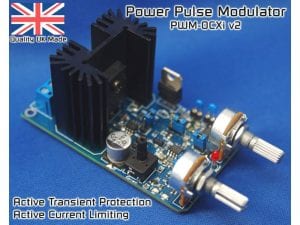 The SSTC Drive Circuit
The SSTC Drive Circuit
Connecting the PWM-OCXi to the primary coil and PSU
It is possible to just use a single OCXi drive circuit to make this work, but this will run the SSTC at a continuous 1MHz. While this will make a great silent plasma plume, it is really hard work for the IGBT in the circuit which means it will quickly heat up and could be damaged if allowed to get too hot. When used in this way it is sometimes refered to as a Continuous Wave SSTC (CWSSTC) due to the fact that the output is a continuous 1MHz high voltage waveform.
It is best to use one OCXi tuned to power the primary coil at 1MHz and then another OCXi (or another low frequency source) to modulate its output. By doing this we can make short 1MHz pulses that create a large spark while not dissipating too much heat over time in the IGBT on the OCXi drive circuit. The OCXi driving the coil will need to have the timing capacitor (C1) replaced with one rated for 22pF so that the frequency range is at the top end.
The diagram shown here shows two OCXi circuits in a Master/Slave setup. The circuits are powered from the same supply and a short wire is connected between the master’s DRV connection and the slave’s EN connection. More details about the master/slave setup can be found in the OCXi datasheet. The slave device is set to power the primary coil at 1MHz with around 50% duty, while the master OCXi is set to around 100Hz and 10% duty. Each time the master OCXi pulses high, the slave circuuit is momentarily activated. The resultant sparks look as good as they would with only one OCXi, but at only 10% of the power used!
It is important to connect a large capacitor such as a 1000uF 50V electrolyitic capacitor close to the power input terminals of the circuit driving the primary coil. This is used to help supply the high current pulses to the coil as a PSU or battery would not be able to do this alone.
 DANGER: This device will create a lot of radio frequency interference!
DANGER: This device will create a lot of radio frequency interference!
Operating the Solid State Tesla Coil
Tuning and running the SSTC
First of all make sure it is set up in a clear space, and it is not near any sensitive electronics. This can cause a lot of interference with nearby electronics such as computers and phones. When doing this project, one of our computer screens around 10m away from the system would flicker when it was running! It would also cause significant problems when trying to make footage of this on our DSLR camera. Interference would reset the camera, or even corrupt the memory cards.
Before powering on the circuits, ensure that the duty setting of the slave OCXi is set to 0% while the frequency is set to maximum. If also using a slave circuit, set its duty to about 10% and the frequency to minimum.
Turn down the lights and then turn on the power to the circuits and slowly turn up the duty on the slave unit to around 50%. Watch the tip of the secondary winding for any glowing purple discharge and SLOWLY adjust the frequency control on the slave circuit until you get the biggest discharge you can. While doing this be make sure you regulary power off the system and check that the heatsink is not getting too hot on the OCXi. You may also notice that simply moving your hand near the circuit or secondary coil will alter the size of the glowing output. This is because moving near it actually alters the systems resonant frequency and therefore detunes if from what you have set on the controls.
Once satisfied with frequency the tuning, adjust the duty settings and frequency of the master circuit to give the desired effect.
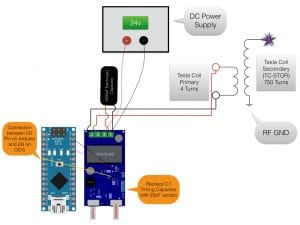 Making a Plasma Speaker
Making a Plasma Speaker
Making music come from the sparks of your SSTC!
The plasma at 1MHz makes almost no sound as 1MHz is well above the audiable range of human ears. When we modulate this frequency with another circuit, we are able to hear the frequency of that modulation. The sound comes from the air expanding around the plasma as it forms during each pulse. We can take advantage of this effect to make the SSTC play music without any speakers at all!
In this example we use an Arduino Nano (programmable circuit) loaded with some code meant to play music on a small speaker. Rather than connecting the output to a speaker, we connect it to the EN connection of the slave OCXi. Doing this causes the Tesla Coil plasma to be modulated at whatever frequency the music is.
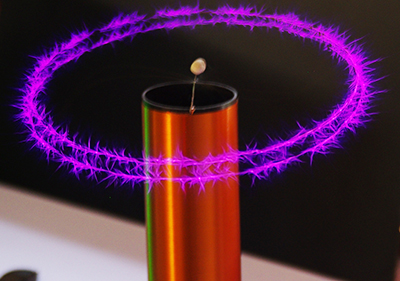 In the videos you can also see a spinning “corona motor”. This is made by simply bending a thin wire into an S shape and making a small loop in the middle so it can be hooked onto a supporting wire. As the plasma forms at the sharp tips of the wire, the air is heated and pushed away giving it some thrust. This will eventually cause the whole wire to spin quite quickly and give this cool looking effect!
In the videos you can also see a spinning “corona motor”. This is made by simply bending a thin wire into an S shape and making a small loop in the middle so it can be hooked onto a supporting wire. As the plasma forms at the sharp tips of the wire, the air is heated and pushed away giving it some thrust. This will eventually cause the whole wire to spin quite quickly and give this cool looking effect!
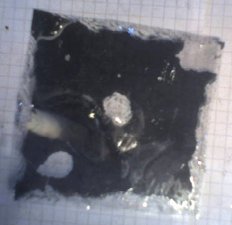 The reflective film used to make one way windows can react quite violently to high DC voltages. The image on the left shows a piece of window film after being exposed to around 30kV from a low current voltage multiplier.
The reflective film used to make one way windows can react quite violently to high DC voltages. The image on the left shows a piece of window film after being exposed to around 30kV from a low current voltage multiplier.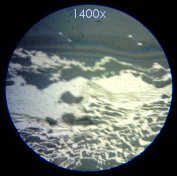
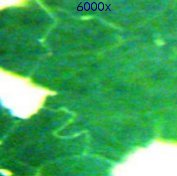

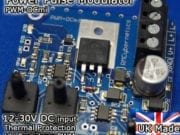 Power Pulse Modulator - PWM-OCmi (HV)
Power Pulse Modulator - PWM-OCmi (HV) 

 These images show how the electrical hot plasma from the Tesla Coil blends with the cold plasma of the flame. Click on the photos for a full view.
These images show how the electrical hot plasma from the Tesla Coil blends with the cold plasma of the flame. Click on the photos for a full view.

 These photos show what happens when pure Neon gas is emitted from the top sphere of a small Tesla Coil. Neon has a much lower ionization voltage than air, so the gas will glow very brightly creating a plasma column to allow the arcs to be much larger. The picture on the right looks similar to the ‘death ray’ devices used in the movie War of the Worlds! You can see when tuned correctly the individual filaments tend to form multiple helices, allowing the plasma column to rise quite high.
These photos show what happens when pure Neon gas is emitted from the top sphere of a small Tesla Coil. Neon has a much lower ionization voltage than air, so the gas will glow very brightly creating a plasma column to allow the arcs to be much larger. The picture on the right looks similar to the ‘death ray’ devices used in the movie War of the Worlds! You can see when tuned correctly the individual filaments tend to form multiple helices, allowing the plasma column to rise quite high.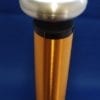
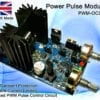
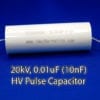

 This part can be quite difficult and time consuming to produce yourself. If you do not want to wind your own, check out our
This part can be quite difficult and time consuming to produce yourself. If you do not want to wind your own, check out our  The primary coil simply consists of around four windings of thick copper wire wrapped around the base of the secondary coil. It is best to use something well insulated as it prevents corona leaking energy from the primary coil. In this example we used
The primary coil simply consists of around four windings of thick copper wire wrapped around the base of the secondary coil. It is best to use something well insulated as it prevents corona leaking energy from the primary coil. In this example we used  The SSTC Drive Circuit
The SSTC Drive Circuit
 In the videos you can also see a spinning “corona motor”. This is made by simply bending a thin wire into an S shape and making a small loop in the middle so it can be hooked onto a supporting wire. As the plasma forms at the sharp tips of the wire, the air is heated and pushed away giving it some thrust. This will eventually cause the whole wire to spin quite quickly and give this cool looking effect!
In the videos you can also see a spinning “corona motor”. This is made by simply bending a thin wire into an S shape and making a small loop in the middle so it can be hooked onto a supporting wire. As the plasma forms at the sharp tips of the wire, the air is heated and pushed away giving it some thrust. This will eventually cause the whole wire to spin quite quickly and give this cool looking effect!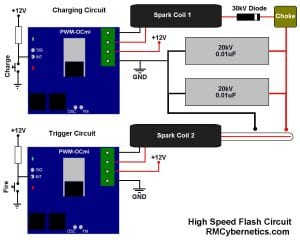 The primary inverter consists of a
The primary inverter consists of a  The high speed flash tube consists of two main electrodes on the outside of a small glass tube, plus a third electrode inside the glass tube so that it is isolated from the others.
The high speed flash tube consists of two main electrodes on the outside of a small glass tube, plus a third electrode inside the glass tube so that it is isolated from the others.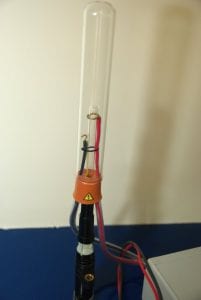
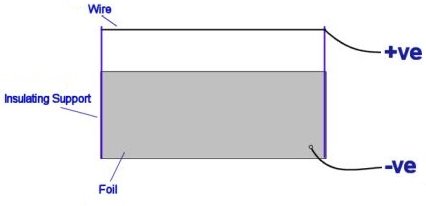
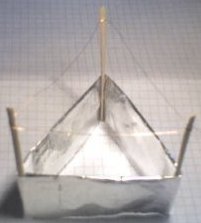 EHDT Construction Details
EHDT Construction Details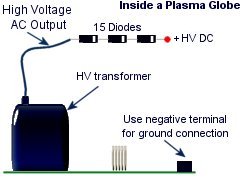
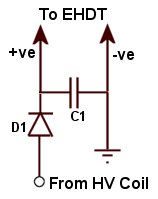 For a tiny Lifter the output of a plasma globe PSU and a
For a tiny Lifter the output of a plasma globe PSU and a 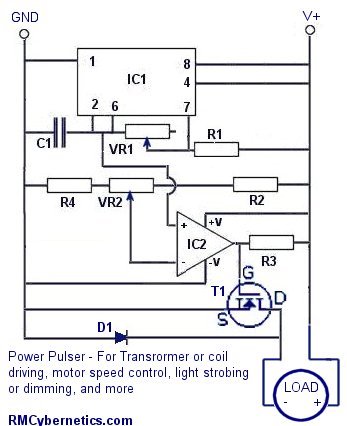


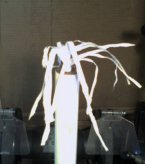 Using a voltage multiplier is a great way to make a high voltage DC power supply. It is very easy to generate high voltages from easily available components.
Using a voltage multiplier is a great way to make a high voltage DC power supply. It is very easy to generate high voltages from easily available components.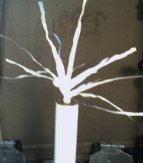 You can see what high voltage static electricity from this device does to a piece of one way window film in the
You can see what high voltage static electricity from this device does to a piece of one way window film in the 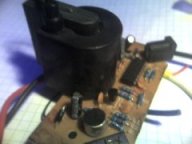
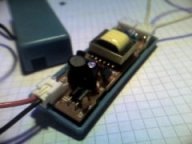
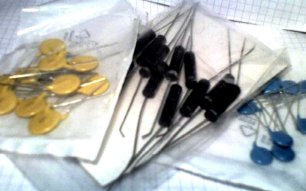 The capacitors and diodes required for the multiplier can be purchased from our
The capacitors and diodes required for the multiplier can be purchased from our 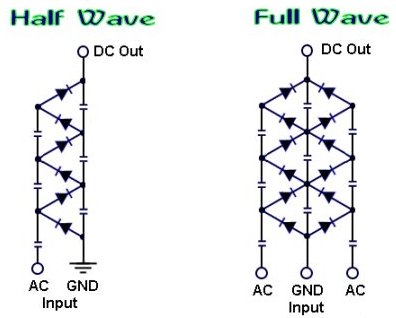
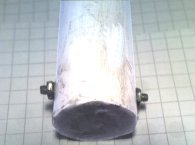 The schematics above will output a positive DC voltage relative to the ground (GND). If a negative output is required then the polarity of the diodes should be reversed. you can learn more about how a voltage multiplier works, by visiting the
The schematics above will output a positive DC voltage relative to the ground (GND). If a negative output is required then the polarity of the diodes should be reversed. you can learn more about how a voltage multiplier works, by visiting the 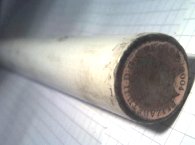 Example Experiments
Example Experiments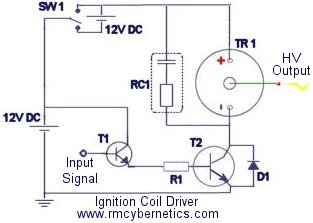
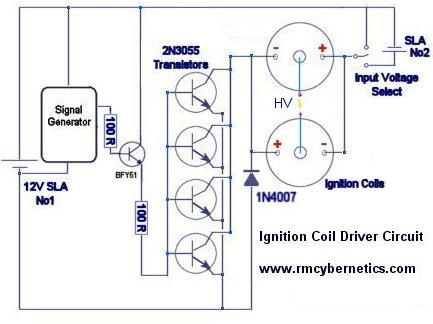 This next circuit is designed for a higher powered output. Two ignition Coils are connected in parallel but with opposite polarity. This means that the output voltages of each coil are out of phase or opposite to each other (when one is positive, the other is negative). Using this configuration the output is taken from the two coils output terminals, whereas the circuit above uses the output terminal and ground.
This next circuit is designed for a higher powered output. Two ignition Coils are connected in parallel but with opposite polarity. This means that the output voltages of each coil are out of phase or opposite to each other (when one is positive, the other is negative). Using this configuration the output is taken from the two coils output terminals, whereas the circuit above uses the output terminal and ground.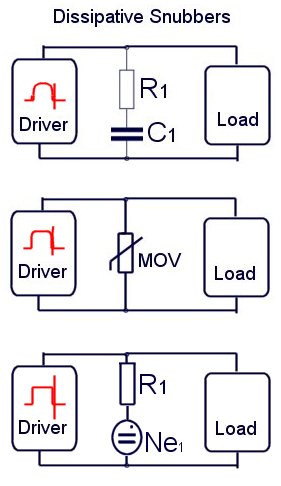 If you build an ignition coil driver to make high voltage sparks and arcs, you will need some sort of EMI protection for your circuit. Without it, it is very likely you will destroy the transistors or driver ICs.
If you build an ignition coil driver to make high voltage sparks and arcs, you will need some sort of EMI protection for your circuit. Without it, it is very likely you will destroy the transistors or driver ICs.